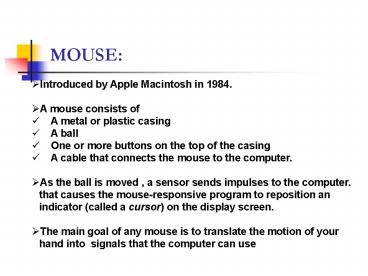MOUSE: PowerPoint PPT Presentation
1 / 13
Title: MOUSE:
1
MOUSE
- Introduced by Apple Macintosh in 1984.
- A mouse consists of
- A metal or plastic casing
- A ball
- One or more buttons on the top of the casing
- A cable that connects the mouse to the
computer. - As the ball is moved , a sensor sends impulses to
the computer. that causes the mouse-responsive
program to reposition an indicator (called a
cursor) on the display screen. - The main goal of any mouse is to translate the
motion of your hand into signals that the
computer can use
2
(No Transcript)
3
- A ball touches the surface and rolls when the
mouse moves. - Two rollers touch the ball. One of the rollers
detects motion in the X direction, and the other
detects motion in the Y direction(90 degrees to
the X). As the ball rotates, one or both of these
rollers rotate as well. - The rollers each connect to a shaft, and the
shaft spins a disk with holes in it. When a
roller rolls, its shaft and disk spin. - On either side of the disk there is an infrared
LED and an infrared sensor. - An on-board processor chip reads the pulses from
the infrared sensors and turns them into binary
data .
4
Optical Mouse
- Developed by Agilent Technologies and introduced
to the world in late 1999. - The optical mouse actually uses a tiny camera to
take 1,500 pictures every second. - Able to work on almost any surface, the mouse has
a small, (LED) that bounces light off that
surface onto a complimentary metal-oxide
semiconductor (CMOS) sensor. - The computer moves the cursor on the screen based
on the - coordinates received from the mouse.
5
Optical mouse versus wheeled mouse
- No moving part means less wear and a lower chance
of failure. - There's no way for dirt to get inside the mouse
and interfere with the tracking sensors. - Increased tracking resolution means smoother
response. - They don't require a special surface, such as a
mouse pad.
6
MONITOR
- The most-used output device on a computer.
- The display provides instant feedback by showing
you text and graphic images as you work or play. - Different type of monitors are
- cathode ray tube (CRT)
- liquid crystal display (LCD)
- light-emitting diode (LED)
- gas plasma
- Monitors using LCD technologies are beginning to
replace the venerable CRT on many desktops.
7
- When purchasing a display, you have a number of
decisions to make. - These decisions affect how well your display will
perform for you, how much it will cost and how
much information you will be able to view with
it.
8
Your decisions include
- Display technology
- CRT or LCD technologies.
- Cable technology
- VGA and DVI are the two most common.
- Viewable area
- (usually measured diagonally)
- Maximum resolution
- Resolution refers to the number of individual
dots of color, known as pixels. Resolution is
typically expressed as 640x480 i.e. number of
pixels horizontally and vertically. - Dot pitch
- The dot pitch is the measure of how much space
there is between a display's pixels.
9
- Color depth
- The combination of the display modes supported
by your graphics adapter. - Amount of power consumption
- CRTs are somewhat power-hungry, especially when
compared to LCDs. - A monitor uses the 80 of the total electricity
of a personal computer.
10
PRINTERS
- A printer is a device that accepts text and
graphic output from a computer and transfers the
information to paper. - Printers vary in size, speed, sophistication, and
cost. - In general, more expensive printers are used for
higher-resolution color printing. - Personal computer printers can be distinguished
as - impact or non-impact.
11
IMPACT PRINTERS
- These printers have a mechanism that touches the
paper in order to create an image. There are two
main impact technologies - Dot matrix printers use a series of small pins to
strike a ribbon coated with ink, causing the ink
to transfer to the paper at the point of impact. - Character printers are basically computerized
typewriters. They have a ball or series of bars
with actual characters (letters and numbers)
embossed on the surface. The appropriate
character is struck against the ink ribbon,
transferring the character's image to the paper.
12
NON-IMPACT PRINTERS
- These printers do not touch the paper when
creating an image. They include - Inkjet printers, use a series of nozzles to
spray drops of ink directly on the paper. - Laser printers, use dry ink (toner), static
electricity, and heat to place and bond the ink
onto the paper. The laser printer uses a laser
beam reflected from a mirror to attract ink
(toner) to selected paper areas.
13
The four printer qualities
- Color
- Color printers can also be set to print only in
black-and-white. Color printers are more
expensive. - Resolution
- Printer resolution is the sharpness of text and
images on paper (measured in dots per inch
(dpi)). - Speed
- If you do much printing, the speed of the printer
becomes important. Inexpensive printers print
only about 3 to 6 sheets per minute. - Memory
- Most printers come with a small amount of memory
(for example, one megabyte) that can be expanded
by the user.

